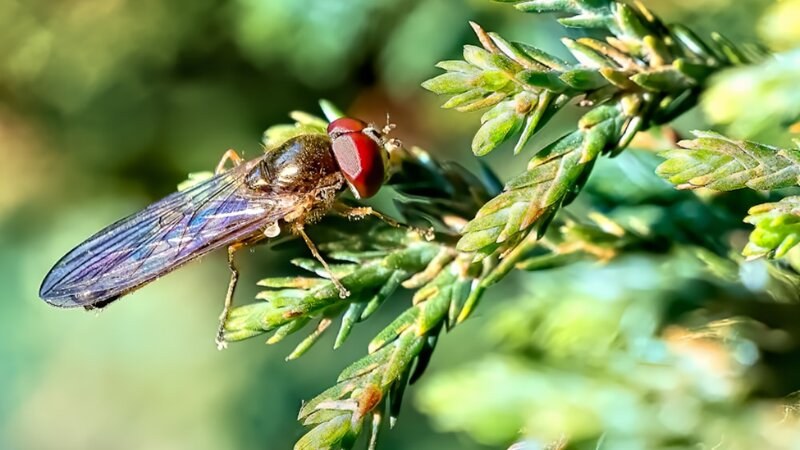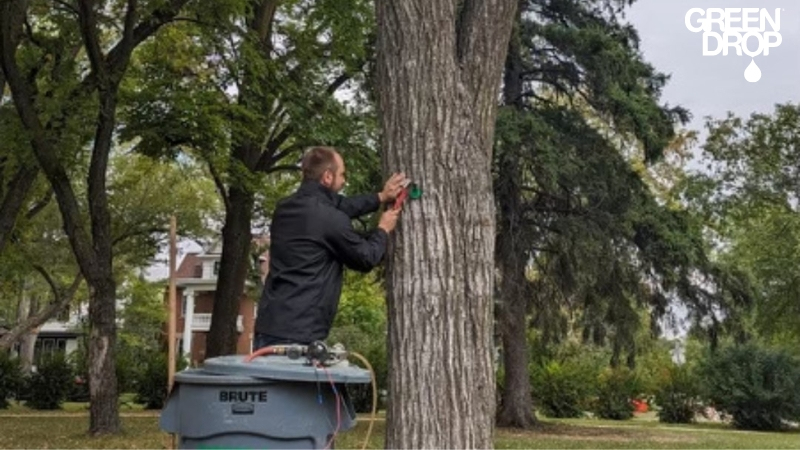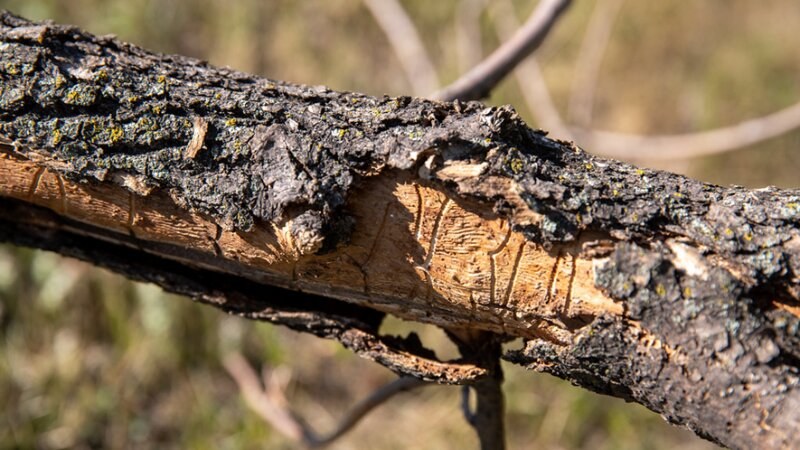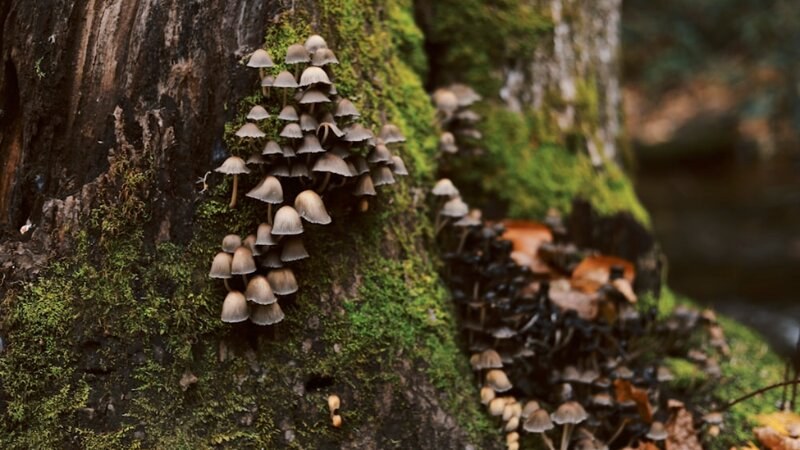10 Common Signs and Symptoms Your Trees Have Pests
Reading time: 6 minutesA healthy tree stands tall, adds beauty to your property, and boosts curb appeal. But when pests move in, your tree can go from a leafy legend to a leafless liability in no time.
If left untreated, these tiny troublemakers can cause significant damage, leading to disease and decay.
To help you spot the signs of trouble before it's too late, we’re breaking down 10 common signs and symptoms your tree has pests. So, grab your magnifying glass, and let's root out the culprits together!

Tree Damage Caused by Pests
Pests can turn your vibrant tree into a sorry sight faster than you can say "timber." These sneaky invaders cause various types of damage that can weaken your tree if left unchecked.
- Caterpillars, beetles, and grasshoppers love to chew leaves, leaving them riddled with holes or completely defoliated.
- Bark beetles and borers drill into the trunk and branches, causing cracks, holes, and missing bark.
- Root rot fungi can devastate the root system, leading to poor growth, wilting, and instability.
- Severe infestations weaken the tree’s structure, resulting in branch dieback, canopy thinning, or even total tree collapse over time.
Early detection is crucial to prevent pests from turning your mighty tree into a pile of mulch.
10 Common Signs and Symptoms Your Trees Have Pests
1. Chewed Leaves
If your tree’s leaves look like a buffet table for bugs, you’re probably dealing with some leaf-munching pests. Chewed leaves often have irregular edges or holes, a telltale sign of hungry caterpillars, beetles, and grasshoppers.

One common culprit is the birch leafminer, which leaves birch tree foliage looking like Swiss cheese. Left untreated, these pests can severely defoliate your tree, stunting its growth and leaving it vulnerable to other diseases.
If you spot this leafy carnage, it's time to call our ISA-certified arborists before your tree becomes the main course.
2. Discoloured or Wilted Leaves
Leaves that turn yellow, brown, or black signal that your tree is under attack. Aphids, scale insects, and spider mites can sap the life out of leaves, leaving them discoloured and drooping.
For instance, spruce trees often fall victim to spider mites, which leave the needles looking pale and sickly. Another common pest, the hemlock woolly adelgid, can cause similar discolouration in hemlocks.
When leaves lose their lustre, it clearly indicates that pests are feeding on the tree's sap or causing disease. Early identification, pruning affected branches, and specific control methods can help manage the infestation and restore your tree's health.
3. Sticky Residue on Leaves
Are you noticing a sticky residue on your tree’s leaves, twigs, or branches? That's honeydew, the sweet but damning calling card of sap-sucking pests like aphids, scale insects, and whiteflies.
These pesky bugs pierce leaves to feed on the sap, leaving behind a sticky substance that can attract mould and other unwanted guests. Maple trees often suffer from aphid infestations, which can coat the leaves in a sugary mess.
If your tree looks like it's been glazed in syrup, it's time to clean up the sticky situation with a thorough tree treatment.
4. Galls and Abnormal Growths
Swellings, bumps, and abnormal growths on your tree's leaves, stems, or branches could be a sign of galls. Gall mites, gall wasps, and aphids inject chemicals into the tree, causing it to produce these unsightly growths.
Oak trees often suffer from oak apple galls, which look like small, round fruit dangling from the branches. While galls themselves are usually not fatal to the tree, they indicate a pest problem that could lead to further damage.
5. Bark Damage
Bark damage is one of the more alarming signs that your tree is in trouble. Cracks, holes, or missing bark on the trunk or branches suggest bark beetles, borers, or canker fungi have made themselves at home.
Emerald ash borer, a notorious pest, leaves distinctive D-shaped exit holes in ash trees, while bark beetles create winding galleries under the bark. This type of damage can weaken your tree structurally and make it more susceptible to diseases.

6. Frass or Sawdust
Frass is a fancy word for the sawdust-like material you might find around the base of a tree or on its branches. It’s a sure sign that borers, bark beetles, or carpenter ants have been busy.
The Asian longhorned beetle, for instance, leaves telltale piles of frass on maple trees as it bores into the wood. If your tree looks like it's been dusted with sawdust, it's time to investigate further.
Left unchecked, these burrowing pests can weaken the tree from the inside out, leaving it susceptible to breakage and disease.
7. Branch Dieback
Branch dieback describes the progressive death of tree branches, starting at the tips and working inward. Common culprits include borers, bark beetles, and canker fungi.
Dutch elm disease, for instance, causes elm tree branches to gradually die back, leaving the tree looking sparse and unhealthy. Other signs of branch dieback include brittle or cracked branches, leaves that don't develop fully, and premature leaf drop.
If your tree exhibits this symptom, it could be a sign that pests are causing internal damage or spreading disease. Early identification and treatment are crucial to prevent the infestation from reaching the trunk and killing the entire tree.
8. Exit Holes
Small, round, or D-shaped holes in a tree's trunk or branches are most likely exit holes. Borers, bark beetles, and weevils create these openings when they emerge from inside the tree.
The bronze birch borer, for example, leaves distinctive D-shaped exit holes on birch trees. Other pests, like the emerald ash borer, create similar holes in ash trees. These tiny portals may seem harmless at first glance, but they indicate an internal infestation that can weaken the tree.
9. Root and Crown Rot
Root and crown rot are sneaky killers, attacking trees from below the surface. Mushrooms or fungal growth around the tree's base, wilting, and poor growth are all red flags.
Armillaria fungus, for example, causes Armillaria root rot in coniferous trees, leading to a gradual decline in health. Phytophthora fungus is another common culprit. These fungi thrive in wet conditions, slowly rotting away the root system and crown.
If you notice mushrooms growing around the base of your tree or observe wilting despite adequate watering, root rot might be the villain lurking underground.

10. Defoliation
Sudden or excessive loss of leaves or needles often indicates that your tree is under attack. Caterpillars, beetles, and sawflies can quickly strip a tree of its foliage, leaving it looking bare and unhealthy.
Gypsy moths are notorious for defoliating oak and maple trees, causing them to lose their leaves en masse. If your tree experiences rapid leaf loss, it may struggle to photosynthesize and grow.
Identifying the pests responsible and treating them promptly can help your tree recover its leafy glory before it’s too late.
Give Your Trees a Fighting Chance with Green Drop’s Tree Care Services
At Green Drop, our team of ISA-Certified arborists knows how to tackle the toughest tree pests in town. With over 19 certified arborists specializing in tree care, we provide comprehensive services to keep your trees in peak condition.
Our services include thorough tree assessments to identify potential issues and evaluate tree health, precise plant disease diagnostics with eco-friendly treatment plans, and customized solutions that address your tree’s unique needs and environment.
Whether it’s pesky bark beetles or insidious fungi, our arborists will root out the problem and nurse your tree back to health. Schedule your tree care assessment with us today, and let our Green Drop tree whisperers help your trees stand tall and pest-free!
Green Drop provides tree care services in Calgary, Edmonton, Red Deer, Regina, Saskatoon, and Winnipeg.

